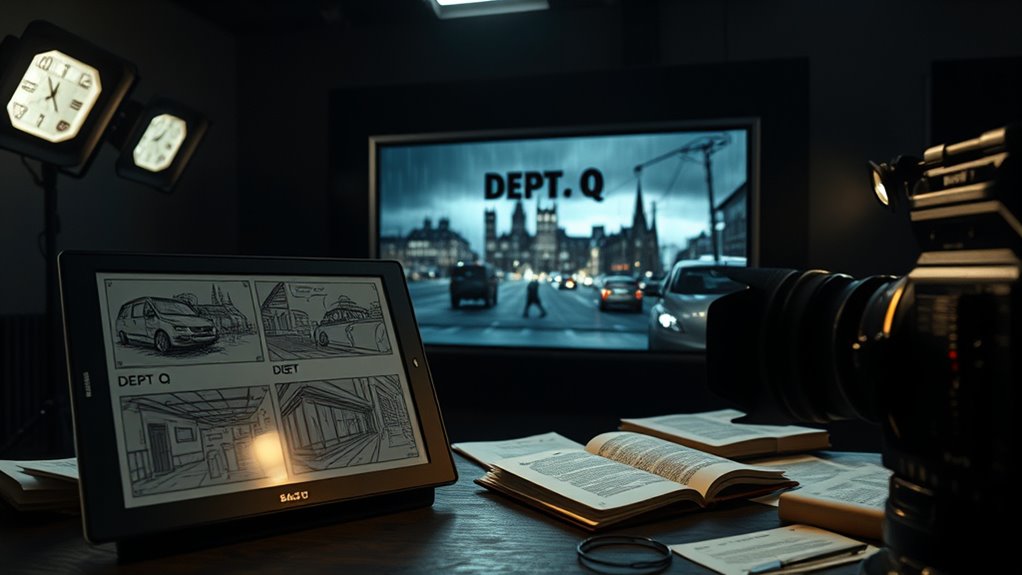When adapting crime novels like *Dept. Q* for TV, focus on balancing fidelity to the source with engaging storytelling. Develop your characters’ motivations, flaws, and growth to build emotional connections, pacing your episodes to heighten suspense without losing depth. Use visual storytelling to clarify complex plots and maintain a smooth flow across episodes. Ultimately, respecting the material while enhancing character arcs and pacing will create a compelling series — stay with us to explore how to master this balancing act.
Key Takeaways
- Prioritize character development by revealing protagonists’ motivations and flaws through expanded scenes.
- Use strategic pacing, including cliffhangers and scene variation, to maintain suspense and viewer engagement.
- Break down complex plots into manageable segments with visual storytelling to prevent confusion.
- Balance true-to-source storytelling with new subplots and characters to enhance depth and freshness.
- Focus on emotional arcs to foster viewer connection, ensuring characters grow naturally over the series.

Adapting crime novels for TV has become a popular way to bring compelling stories and complex characters to a wider audience. When you take a beloved novel like *Department Q*, you have to balance staying true to the source material with the demands of episodic storytelling. One of the most critical aspects is character development. You want viewers to feel connected to the protagonists, such as Carl Mørck and Assad, by revealing their motivations, flaws, and growth over time. This means carefully selecting key scenes from the novel that highlight their personalities and struggles, then expanding on those moments to deepen viewer engagement. You also have to be mindful of how to introduce new characters or subplots without overwhelming the main story, ensuring each character’s arc feels natural and meaningful. Strong character development keeps viewers invested and enthusiastic to follow each episode, making the story resonate long after the credits roll.
Equally important are pacing techniques. Crime novels often have a deliberate rhythm, with tension building gradually as clues are uncovered. When adapting to TV, you need to manipulate pacing to sustain suspense across episodes. This involves strategically placing cliffhangers, quickening the tempo during moments of action or revelation, and slowing down during introspective scenes that reveal character depth. You might extend certain plot points or add new scenes that weren’t in the book to maintain momentum. Pacing techniques also help you manage the story’s complexity, preventing it from becoming overwhelming or confusing. For example, breaking up intricate plot lines into manageable segments ensures viewers stay engaged without feeling lost. Additionally, understanding the importance of visual storytelling can enhance narrative delivery and audience engagement. The key is to balance moments of high tension with quieter scenes that develop characters and themes, creating a rhythm that keeps viewers hooked from episode to episode.
In the end, successfully adapting a crime novel like *Department Q* hinges on your ability to craft a compelling narrative that respects the source material while enhancing it for television. You must focus on character development to forge emotional connections and employ pacing techniques to maintain suspense and momentum. When done right, your adaptation becomes more than just a retelling; it transforms into an immersive experience that captures the essence of the original story while offering fresh insights and visual storytelling. This careful balance ensures your series appeals to fans of the book and newcomers alike, solidifying its place as a gripping crime drama on screens everywhere.
Frequently Asked Questions
How Do You Choose Which Crime Novels to Adapt for TV?
You should select crime novels that offer strong visual storytelling and compelling characters, which translate well to screen. Look for stories with unique plots and rich atmospheres to engage viewers. Consider casting choices early, ensuring the characters’ personalities shine through. A good adaptation balances the novel’s essence with visual appeal, making it easier to connect with audiences and bring the story vividly to life on TV.
What Are Common Challenges in Translating Novels to Screen?
You might think translating novels to screen is straightforward, but challenges like balancing visual storytelling and staying true to the book can be tough. Casting decisions are vital because actors bring characters to life, but they also shape audience perception. Ensuring pacing remains engaging while capturing the novel’s depth requires careful adaptation. Overcoming these obstacles means focusing on strong visuals and thoughtful casting to create an authentic, compelling TV series.
How Do You Balance Faithfulness and Creative License?
You balance faithfulness and creative license by prioritizing visual fidelity to key story elements while allowing for narrative innovation that enhances pacing and character development. Stay true to the core themes and plot details that fans love, but don’t be afraid to tweak dialogues or scenes to better suit the visual medium. This approach keeps viewers engaged and respects the source material, creating a compelling and authentic adaptation.
What Role Does Fan Expectation Play in Adaptations?
Did you know 70% of fans say they’re more engaged when adaptations meet their expectations? Fan expectation shapes your approach, as it influences fan engagement and how you manage spoilers. You need to listen to fans’ hopes while balancing creative choices. Managing spoilers keeps excitement alive, ensuring viewers stay invested. Respecting fan expectations helps you build loyalty, making your adaptation more successful and satisfying for audiences craving authenticity.
How Do You Ensure the Tone Matches the Original Novel?
To guarantee the tone matches the original novel, you focus on maintaining the visual tone and character consistency. You collaborate closely with the creators and authors to capture the book’s atmosphere, using consistent visual styles, color palettes, and pacing. You also keep characters true to their original personalities, ensuring their development feels authentic. By aligning these elements, you preserve the novel’s mood and integrity, satisfying fan expectations.
Conclusion
So, when you adapt crime novels like *Dept. Q* for TV, remember that staying true to the book’s core while adding visual depth keeps viewers hooked. Consider whether complex characters or intricate plots truly translate well to screen—sometimes, simplifying or emphasizing certain elements makes all the difference. Ultimately, blending faithfulness with creative interpretation not only honors the original but also deepens audience engagement, proving that a well-crafted adaptation can uncover new layers of a beloved story.










